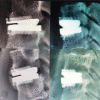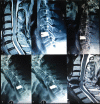Implant complications after one-level or two-level cervical disc arthroplasty: A retrospective single-centre study of 105 patients
- PMID: 32957345
- PMCID: PMC7505342
- DOI: 10.1097/MD.0000000000022184
Implant complications after one-level or two-level cervical disc arthroplasty: A retrospective single-centre study of 105 patients
Abstract
The aim of study was to investigate the complications of cervical disc arthroplasty (CDA) and to discuss the factors affecting the mobility of the prosthesis and the measures to prevent these complications. Hundred and five patients who underwent CDA between 2009 and 2016 were enrolled. The clinical and radiographic outcomes were used to assess and the complications were recorded as well.All the patients were followed-up with an average of 41.30 ± 16.90 months with an average age of 47.90 ± 9.22 years. The visual analogue scale (VAS), neck disability index (NDI), and Japanese Orthopaedic Association (JOA) scores improved significantly at the final follow-up (FU) compared with the preoperative values. At the final FU, the overall incidence of heterotopic ossification (HO) was 51.42%. The distribution of different grades of HO was low-level HO (53.7%) and high-level HO (46.3%). No significant differences were found in the NDI, VAS, or JOA scores between patients with HO and those without HO (P > .05). In the high-level HO patients, the range of mobility (ROM) was significantly reduced compared with the low-level HO patients and those without HO (P < .05). The anterior displacement, subsidence, and instability were observed in 1 patient respectively and the segmental kyphosis, adjacent segment degeneration in 3 patients respectively. The patient of CDA instability also suffered severe neck pain and the revision surgery was performed.Postoperative complications in CDA such as HO, segmental kyphosis, and prosthesis displacement are prone to occur, affecting prosthesis mobility. Surgical indications should be strictly controlled, and intraoperative and postoperative treatments should be given great attention in order to reduce prosthesis-related complications.
Figures





Similar articles
-
Can segmental mobility be increased by cervical arthroplasty?Neurosurg Focus. 2017 Feb;42(2):E3. doi: 10.3171/2016.10.FOCUS16411. Neurosurg Focus. 2017. PMID: 28142280
-
[Analysis of infuence factors of anterior bone loss after cervical disc arthroplasty and its effect on effectiveness].Zhongguo Xiu Fu Chong Jian Wai Ke Za Zhi. 2021 Jan 15;35(1):26-32. doi: 10.7507/1002-1892.202008126. Zhongguo Xiu Fu Chong Jian Wai Ke Za Zhi. 2021. PMID: 33448195 Free PMC article. Chinese.
-
High prevalence of heterotopic ossification after cervical disc arthroplasty: outcome and intraoperative findings following explantation of 22 cervical disc prostheses.J Neurosurg Spine. 2012 Aug;17(2):141-6. doi: 10.3171/2012.4.SPINE12223. Epub 2012 Jun 1. J Neurosurg Spine. 2012. PMID: 22657947 Review.
-
Incidence of bone loss after Prestige-LP cervical disc arthroplasty: a single-center retrospective study of 396 cases.Spine J. 2020 Aug;20(8):1219-1228. doi: 10.1016/j.spinee.2020.05.102. Epub 2020 May 20. Spine J. 2020. PMID: 32445801
-
Is Gender a Factor Affecting Long-Term Heterotopic Ossification Incidence After Single-Level Cervical Disc Arthroplasty?World Neurosurg. 2022 Sep;165:6-12. doi: 10.1016/j.wneu.2022.06.009. Epub 2022 Jun 7. World Neurosurg. 2022. PMID: 35688374 Review.
Cited by
-
The Role of Cervical Disc Arthroplasty in Elite Athletes.Curr Rev Musculoskelet Med. 2023 Sep;16(9):432-437. doi: 10.1007/s12178-023-09858-8. Epub 2023 Jul 12. Curr Rev Musculoskelet Med. 2023. PMID: 37436652 Free PMC article. Review.
References
-
- Gornet MF, Lanman TH, Burkus JK, et al. . Cervical disc arthroplasty with the Prestige LP disc versus anterior cervical discectomy and fusion, at 2 levels: results of a prospective, multicenter randomized controlled clinical trial at 24 months. J Neurosurg Spine 2017;26:653–67.. - PubMed
-
- Delamarter RB, Zigler J. Five-year reoperation rates, cervical total disc replacement versus fusion, results of a prospective randomized clinical trial. Spine (Phila Pa 1976) 2013;38:711–7.. - PubMed
-
- Mehren C, Suchomel P, Grochulla F, et al. . Heterotopic ossification in total cervical artificial disc replacement. Spine (Phila Pa 1976) 2006;31:2802–6.. - PubMed
-
- McAfee PC, Cunningham BW, Devine J, et al. . Classification of heterotopic ossification (HO) in artificial disk replacement. J Spinal Disord Tech 2003;16:384–9.. - PubMed
Publication types
MeSH terms
LinkOut - more resources
Full Text Sources
Medical

